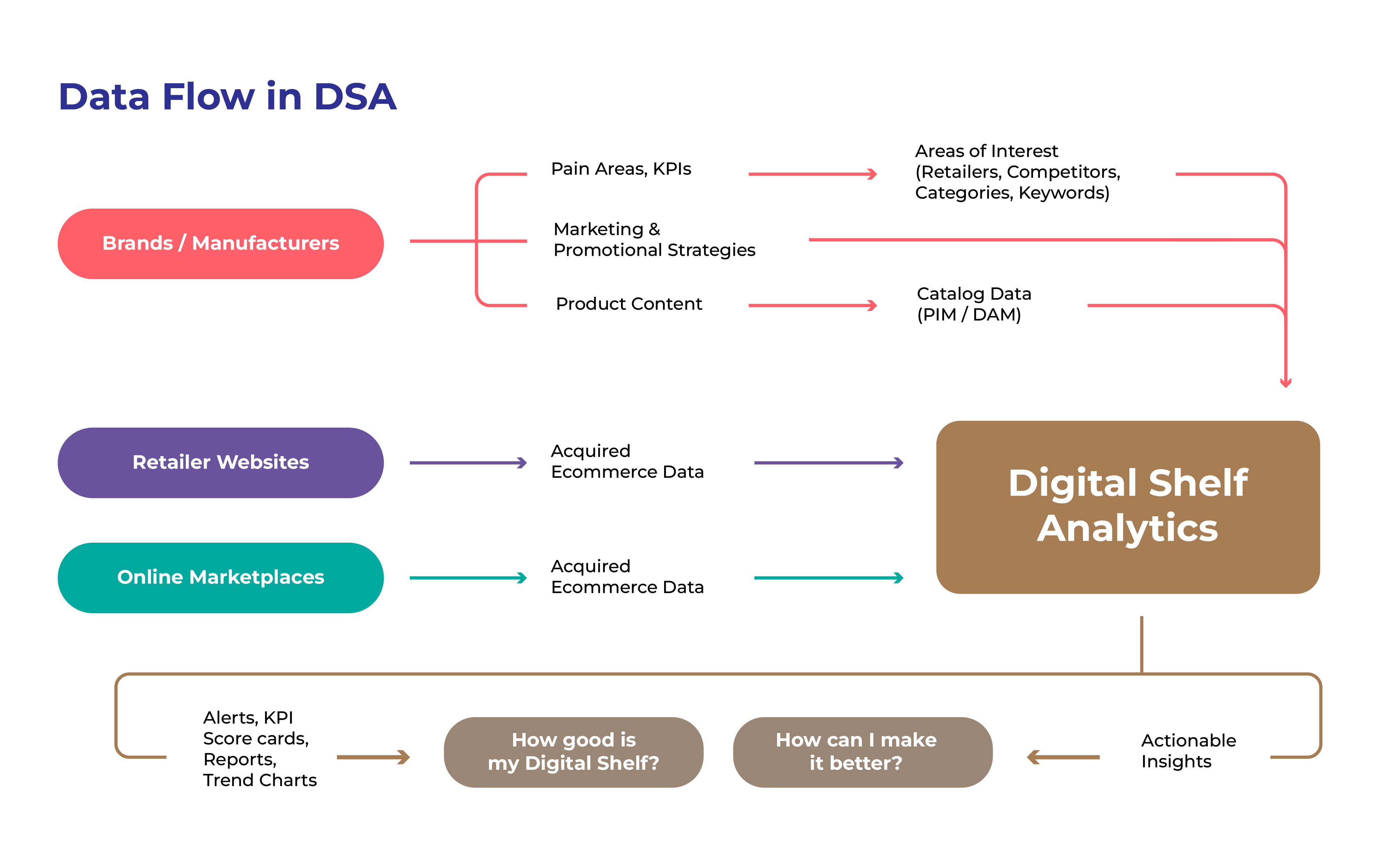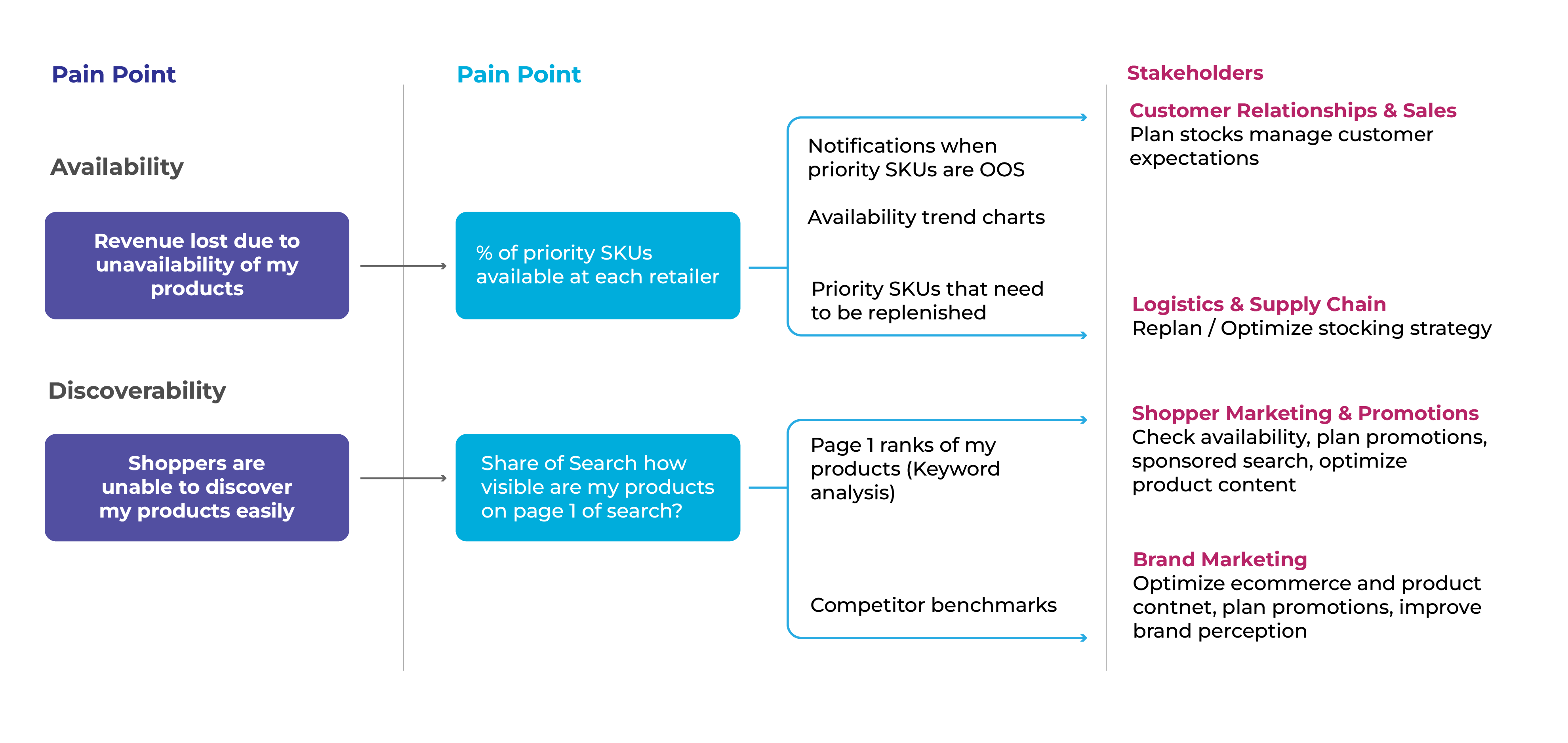What’s in the article:
- Introduction
- What is Digital Shelf Analytics?
- Digital Shelf Analytics Solutions across the Buyer Journey
- Getting Started with Digital Shelf Analytics
- Implementing Digital Shelf Analytics
- Kickstart your Digital Shelf Analytics Journey
- How available are your key products on popular retail platforms across cities and stores?
- How soon are your products replenished once they go out of stock?
- How easily can shoppers find your products?
- Are your products winning the Buy Box most of the time?
- How do your products compare against that of competitors and category bestsellers in terms of availability, discoverability and price position?
- What is the consumer perception of your brand?
- How can you make your products more discoverable?
- How can you increase conversion and market share?
- How can you enhance profitability?
- Availability: are your products in stock?
- Content Quality: what is the quality of the online content of your products?
- Share of Search & Category: what is the proportion (or share) of your products in the search results for specific keywords or category pages?
- Rating and Reviews: how well are your products rated and reviewed?
- Pricing and Promotions: are your products competitively priced and promoted adequately?
We are in a digital-first era that is marked by an increased adoption of eCommerce across all market segments. Research indicates that eCommerce contributes close to 20% of the total retail sales worldwide, and this is projected to grow up to 24% by 2026. The digital shelf - the online equivalent of a brick-and-mortar store - is how brands primarily interact with consumers today. While this has enhanced accessibility to shoppers for brands, it comes with increased complexity and dynamics. Winning the digital shelf becomes a key prerequisite for profitable eCommerce. If you’re a brand, the first step to winning the digital shelf is to understand your digital shelf performance.
You need to know:
Once you comprehend your digital shelf performance, you need comprehensive and timely insights to improve it.
Digital Shelf Analytics enables brands to find answers to the above questions.
What is Digital Shelf Analytics?
Digital Shelf Analytics is the systematic and periodic gleaning and analysis of publicly displayed eCommerce data on retail websites. Brands can use digital shelf analytics to obtain a holistic view of their digital shelf performance and gain actionable insights to win sales on the digital shelf. Ideally, brands must track the top 20% of their products that contribute to 80% of their revenue across key online marketplaces.
As a brand, your digital shelf performance is measured via key performance indicators (KPIs) such as:

Digital Shelf Analytics Solutions across the Buyer Journey
Digital shelf analytics is closely associated with the marketing funnel of brands, i.e. the journey customers take in their path to purchase. This journey starts with the awareness of a product, followed by engagement and evaluation against competing products, and finally the purchase and post-purchase engagement.
Digital shelf analytics provides a comprehensive measure of how each part of the customer journey is performing, as shown in the following table.

Awareness
Typically, a consumer’s first action when she visits an online marketplace is to initiate a product search. This corresponds to the awareness phase at the top of the marketing funnel. If you’re a brand, the more discoverable your products are, the better the consumer awareness and reach. Several factors can affect the discoverability of a product such as its stock availability, promotions and discounts, content quality (including the choice of appropriate keywords in the title and description), and so on. Even short term stock outs can make your search ranking slide down, impacting you in the long term.
Digital Shelf Analytics, through its KPIs, can monitor and measure the discoverability of your products and also provide actionable insights to enhance your consumer reach. Metrics such as share of search, share of category, and share of media (or promotions), benchmark the discoverability of your products against competitors. Correlation across different metrics can help brands identify the reasons for the perceived performance and take appropriate remedial actions. For example, a low search ranking could be due to a stock out. Poor content quality (such as a badly described product or improper choice of keywords in the title) or poor ratings or reviews can pull down the rank of a product.
For more information on how to apply DSA to enhance your product's discoverability on the digital shelf, check out our eBook, Using Digital Shelf Analytics to Enhance your Product's Discoverability.
Engagement
From the products that appear on the first page of search results, the consumer makes a high level short list of products she is interested in, based on their description, features and reviews. Content quality, brand perception and product sentiment play a critical role in this phase. Digital Shelf Analytics’ content audits can ensure that the product content is compliant, lucid, and comprehensive enough to engage customers.
For more information on how to track, assess, and optimize your eCommerce product content, check out our eBook, Mastering Digital Shelf Content With AI.
Evaluation
Analysis of ratings and reviews can help brands understand customer sentiment and act accordingly. The final decision to purchase is made after careful consideration of prices and discounts across retailers.
Competitive pricing and discounting are necessary to influence consumers to make the purchase decision. The pricing intelligence and discount analysis modules of Digital Shelf Analytics educate brands on the pricing and promotion landscape across retailers and competitors and can, therefore, facilitate optimal pricing and discounting to increase their conversion rates.
Purchase
Availability analysis helps brands ensure their products are not stocked out at the point of purchase. The availability of their products also plays a crucial role for brands in the Awareness stage of the buyer journey, since it’s common on online marketplaces for stocked out products to not be visible in category pages or search results.
Post-Purchase
Post-purchase, consumers sometimes post their reviews and ratings on the product. Digital Shelf Analytics can enable brands to gauge customer loyalty through its ratings and reviews and brand sentiment analysis. This further helps brands in the evaluation stage of the buyer journey.
Getting Started with Digital Shelf Analytics
Analytics requires data. The primary step to get started with Digital Shelf Analytics is to identify your relevant digital shelf data and derive analytics that are of interest to you. Learn how to pick your relevant data through the examples mentioned below.
Capturing Relevant Data: Who and What to Track?
Retailers:
Track your biggest or more important online retail partners for each category of products you sell. For example, the following are some of the leading retailers for popular consumer product categories.
- Grocery: Amazon, Walmart, Kroger, Instacart
- Office Supplies: Amazon, Walmart, Target, Office Depot
- Health and Beauty: Amazon, Walmart, Target, Walgreens, CVS
- Home Improvements: Amazon, Home Depot, Lowes, Walmart, Target
- Pet Care: Amazon, Walmart, Chewy, PetSmart
Brands and Products:
Focus on the top 20% of products that account for 80% of your revenue. Also track your top 5-10 competing brands to better understand how you fare in your competitive environment.
Key Performance Indicators:
Derive KPIs from your pain areas and customize as needed.

Implementing Digital Shelf Analytics
In this section we will discover how to apply the insights provided by Digital Shelf Analytics to enhance your product’s performance on the digital shelf.
The better your products capture the shopper’s attention, the higher the chances of them getting into the cart. Digital Shelf Analytics helps you to understand the discoverability of your products through a variety of metrics and performance indicators.
In addition, it can generate actionable insights that you can use to further enhance your customer visibility and engagement. Below, for each KPI, associated metrics, views and actionable insights are outlined. The metrics are a measure of the KPI and the views help you understand trends and behaviors. Brands can leverage the actionable insights to discover and alleviate pain points and improve their digital shelf presence.
Availability score
"Unavailable products cannot be purchased"
Metrics:
- Measure of the percentage of eCommerce product listings where your product is in stock
- Availability score is 50 if your product is ‘in-stock’ at 2 out of 4 online retailers
Important Views:
- Aggregated availability
- Availability scores across brands, retailers, cities and categories
- Historical availability charts
- View products grouped by availability
- Out-of-stock alerts
Actionable Insights:
- Which of your products have a low aggregate availability?
- In which city are your products not in stock?
- Are there some product categories where you need to optimize your stock planning?
- Any top retailers where your best-selling products are consistently out of stock?
- Is there a supply chain issue?
Share of Search (SoS)
“If I don't appear in the first page of search, I don't make my way to the cart”
Metrics:
- Proportion of your products in the search results for a particular keyword and retailer
Important Views:
- Aggregated SoS
- Organic and Sponsored SoS scores
- SoS scores across brands, retailers, keywords, cities
- Historical SoS score trends
Actionable Insights:
- Which of your products have the lowest SoS score?
- Which products feature low on SoS because they are out of stock?
- Are your competing products faring better due to sponsored searches?
- Is your SoS low due to poor content quality?
Share of Category (SoC)
"If my products do not catch the eye on the category page, they will not be bought"
Metrics:
- Proportion of your products in the category page of a retailer
Important Views:
- Aggregated SoC
- SoC scores across brands, cities, retailers and navigation paths
- Historical SoC score trends
- Organic and Sponsored SoC scores
Actionable Insights:
- In which categories do you have a good digital presence?
- Where should you promote more? Is your SoC lower due to low availability?
- Are there any key cities or locations where you need to strategize to improve my visibility?
Content Quality
“A badly described product will remain unsold”
Metrics:
- Define attributes of product content and reference guidelines for each attribute
- Content Quality score is a measure of degree of compliance to the reference guideline
Important Views:
- Aggregated Content Quality Score
- Content Quality distribution across retailers, attributes, and time
Actionable Insights:
- How does your content quality fare against that of your top-performing competitors?
- Is your ‘discoverability’ compromised due to poor content quality?
- Which of your products can be described better?
Kickstart your Digital Shelf Analytics Journey
To get started with Digital Shelf Analytics, you need to first identify your relevant eCommerce data - which retailers, brands and products to track. Study your pain areas to derive performance indicators and customize them as needed. Systematically chalk out key business questions based on your pain areas. If your pain area is poor discoverability, identify KPIs and associated metrics that can help you understand and quantify your discoverability. Finally, act on the insights provided to address your business challenges and measure its impact on an ongoing basis.
Driving digital shelf optimization for your brand is no mean feat. It requires sophisticated approaches, technologies, and systems to pull off in a consistent and effective way. Therefore, partnering with the right provider of Digital Shelf Analytics solutions is key.
DataWeave is the most comprehensive, scalable, and accurate digital shelf analytics platform in the world. Our AI platform transforms the way consumer brands analyze and optimize their digital shelf, thereby enabling you to enhance how your products are represented, discovered, and sold online.
Our suite of solutions is location-aware, providing nation-wide coverage across all digital shelf KPIs, including a comprehensive view of competition. These insights can be customized and integrated across various other systems and tools, enabling a seamless flow of information and insights across your organization.
With DataWeave, you have a partner that understands the key role that digital shelf KPIs play in unlocking opportunities for growth.
So request a demo today to learn more about our solutions!
Book a Demo
Login
For accounts configured with Google ID, use Google login on top.
For accounts using SSO Services, use the button marked "Single Sign-on".
